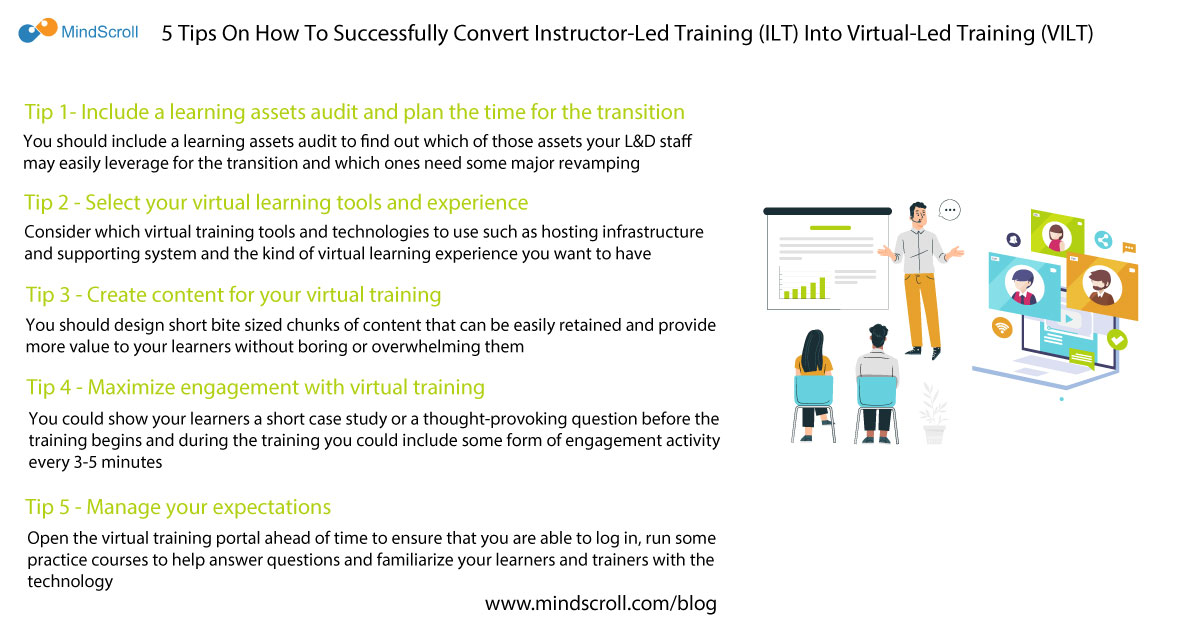Successfully converting instructor-led training (ILT) into virtual-led training (VILT) takes some real work where the training elements gradually move from ILT to VILT and ultimately to a fully self-paced training model. Today many companies are shifting to virtual training as it can be more effective and engaging.
In this article, we share 5 practical tips to help you create highly impactful virtual training programs by successfully converting instructor-led training (ILT) into virtual-led training (VILT):
Tip 1 - Include a learning assets audit and plan the time for the transition
Virtual training is more than just digitizing your existing training content and then hosting them on an eLearning platform. So when converting your existing training into virtual training, you should include a learning assets audit to find out which of those assets your L&D staff may easily leverage for the transition and which ones need some major revamping.
Next you also need to plan the time it will take to shift from instructor-led training to virtual-led training. It can sometimes be quick or sometimes take more time than you expected. For instance, you will save a lot of time converting ILT into VILT when writing course objectives. But you will save little to no time in planning instructional strategies, writing test questions, storyboards, scripts, making graphics, design interface, recording, editing, QA and testing in the LMS, etc.
Tip 2 - Select your virtual learning tools and experience
Consider which virtual training tools and technologies to use such as hosting infrastructure (bandwidth, cloud-based, local server-hosted) and supporting systems, such as LMS (Learning Management System), Course Management Systems (CMS) and Learning Experience Platform (LXP).
Also carefully select the kind of virtual learning experience you want to have in your training courses. For example, you could use webinars for some real-time interaction between the trainer and the learners. Moreover, as they allow for higher engagement through polls/Q&A sessions, making webinars for topics that your learners are already vaguely familiar with would be ideal.
Similarly you could use webcasts for a large audience that doesn’t need access to data in real-time nor a lot of interaction between the trainer and learners. Lastly you could use virtual instructor-led training courses that are the closest to in-person training encouraging learners to take the training experience beyond the screen and usually led with a small audience for high engagement.
Tip 3 - Create content for your virtual training
When creating content for your virtual training courses, you need to consider the fact that less is more. So you should design short bite sized chunks of content that can be easily retained and provide more value to your learners without boring or overwhelming them.
You could mix the short training sessions with brief and interesting offline activities to further reinforce your training. You could also make a recording of the trainer’s words as recordings would make useful raw materials where learners can easily hear the examples, comments and questions of their trainers. Moreover, reviewing learner feedback and interviewing trainers on topics like what's working and not working in ILT, which parts excite or bore learners, what do learners/trainers struggle with etc will help you to know more about the content and classroom experience.
Tip 4 - Maximize engagement with virtual training
The next important step is to make sure that you invest in training everyone - trainers, SMEs, tech support, L&D professionals, and course administrators before launching any virtual training programs.
It is also essential to maximize engagement with virtual training. Engagement is a crucial component of any training process since higher engagement will lead to more content retention. You could show your learners a short case study or a thought-provoking question before the training begins to build interest and keep learners focussed. You could also ask your trainers about what they would change and why.
Then you could begin the session with a short activity instead of traditional classroom icebreakers to encourage participation. During the training you could include some form of engagement activity every 3-5 minutes. For example, you could have break-out groups share their answers at the end of training sessions. Lastly after the training ends, you could send your learners some extra resources or links for learning and encourage them to interact with each other outside of the training.
Point 5 - Manage your expectations
Lastly you need to know that there is a learning curve in shifting from ILT to VILT as learners will need to feel comfortable using the technology. So always be prepared for an adjustment period. Open the virtual training portal ahead of time to ensure that you are able to log in. Run some practice courses to help answer questions and familiarize your learners and trainers with the technology. Give breaks in between sessions for learners to refresh themselves. Use producers who can easily troubleshoot, monitor chat windows, and manage breakout sessions.
Final Thoughts
To summarize, transitioning from instructor-led training to virtual-led training will make your training sessions more engaging, interactive, resonate with your learners, achieve your learning objectives, and facilitate long term growth. We hope you found this article useful in giving you some insights which you can use to successfully make the move to virtual training.
Schedule a demo if you want to know how you can use MindScroll LMS for converting your instructor-led training to virtual training. If you have any queries, do contact us at yg@infonative.net
Did you like this blog post? Does your LMS support virtual training? Do you know of any other tips to make the transition from ILT to VILT easier? Tell us your thoughts or share this blog post on our social media platforms below:
Facebook (@MindScroll) | Twitter (@mindscroll_lms) | LinkedIn (@MindScroll) | Instagram (@mindscroll_lms)
Don’t forget to check our blog for resources you and your team may need.
Read next: 5 Steps To Creating A Successful Mobile Learning Strategy For Corporate Training
LMS, Learning Management System, Cloud LMS, Open Source, Moodle Alternative, Learning Platform, Virtual Classroom, Latest Technology Trends, Learning Technologies, Corporate Learning Strategy, Corporate LMS, ILT, Instructor Led Training, Create Online Courses, Elearning




